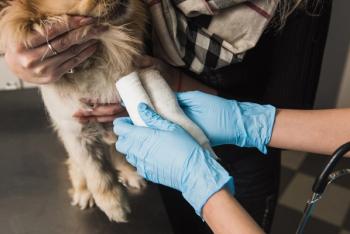
Guidelines for plasma and red cell therapy in critical patients (Proceedings)
Plasma might be administered for its albumin or coagulation factor content.
Plasma
Plasma might be administered for its albumin or coagulation factor content. Albumin is important to colloid osmotic pressure and because it is negatively charged is an important carrier of certain cations, drugs, hormones, metals, enzymes, chemicals, and toxins.
Plasma, which has been separated from collected whole blood, could be administered to supplement albumin concentration and colloid osmotic pressure, but is expensive (compared to artificial colloids) and not very effective, particularly in the face of ongoing protein losses. Prepared plasma products, when they are diluted with anticoagulant, have an albumin concentration that is lower than it was in the donor. Large volumes would be necessary to affect albumin concentrations in the recipient.
The provision of coagulation factors is the most common reason to administer plasma. Whole blood and fresh plasma (within 8 hours of its collection) contains all of the coagulation factors and, depending on how it was separated, most of the platelets contained in the whole blood from which it is derived. A hard spin at 5000 rpm for 5 minutes places the platelets in the buffy coat; the plasma supernatant has no platelets. Platelet rich plasma is produced with a soft spin of about 2500 rpm for 2.5 minutes which does not separate the platelets from the plasma. Platelet rich plasma is produced by harvesting the buffy coat after a hard spin. Whole blood and plasma products intended for use for its platelets should be maintained at room temperature and gently rocked. Refrigeration or freezing destroys platelet activity. Fresh plasma and fresh frozen plasma is efficacious for the treatment of all coagulation disorders. Fresh frozen plasma (within 6 to 8 hours) preserves all of the labile (V, VII, and vonWillebrand's) and stabile (fibrinogen, II, VII, IX, X, XIII, and antithrombin) coagulation factors (Nilsson L, 1983; Sidhu RS, 2006; Furianello T, 2006). Refrigerator storage is associated with a significant loss of factor VIII and vonWillebrand's activity by 24 hours and of factors V and XI by one week (Nilsson L, 1983; Sidhu RS, 2006; Furianello T, 2006). Cryoprecipitate provides a concentrated source of factor VIII, XIII, von Willebrand's, fibrinogen, and fibronectin (Lundberg GD, 1994). Refrigerator stored plasma, plasma frozen after 8 hours post-collection, and fresh frozen plasma beyond one year still contains the stabile factors and is effective for the treatment of warfarin-related rodenticides.
In addition to worsening of congestive heart failure, rebleeding, and dilutional anemia, plasma administration is relatively expensive. Homologous albumin infusions may occasionally be associated with a transfusion reaction. Twenty-five percent human albumin has been administered to dogs and very effectively augments plasma protein concentration and colloid osmotic pressure (Mathews KA, 2005). First time infusions, however, have been associated with acute and delayed transfusion reactions (Francis AH, 2007; Cohn LA, 2007).
Hemoglobin
Blood must be anticoagulated when it is collected into an artificial container for subsequent administration. Heparin could be used if the blood is to be immediately re-transfused (a minimum of 1 unit of heparin/ml of whole blood). However, acid-citrate-dextrose (ACD) or citrate-phosphate-dextrose (CPD) (0.15 ml of solution/ml of whole blood) are more commonly used. CPD-A1 provides 70% red cells viability for up to 5 weeks. After this time, the plasma can be separated and stored frozen. Infused blood should be filtered.
Although many canine erythrocyte antigens have been identified, only 6 (DEA 1.1, 1.2, 3, 4, 5, and 7) are commonly tested (Hale AS, 1995). Dog erythrocyte antigen 1.1 and 1.2 are the most antigenic and are present in approximately 62% of the canine population (Hale AS, 1995). Fortunately naturally-occurring isoantibodies to DEA 1.1 and 1.2 do not exist and, in this regard, first-time transfusions are relatively safe. Donors and recipients should be DEA 1.1 and 1.2 typed to assure that recipients receive type-similar blood. DEA 1.1 and 1.2 negative recipients should not receive type-positive blood because it would prime them from a second-time transfusion reaction. The other four canine blood groups are weak antigens as are any naturally-occuring isoantibodies and transfusion reactions are mild if they occur at all. In vitro cross matching would help sort out potentially incompatible transfusion from any cause and may be important for sequential transfusions and in immune-mediated hemolytic anemia.
There are primarily two commonly identified red cell antigens in the domestic cat — A and B (a third type, AB, is rare). The domestic "mongrel" cats, Siamese, Burmese, and Russian Blue breeds are typically Type A (Griot-Wenk ME, 1995). Type B blood types occur in up to 10% of Maine Coon cats, up to 20% in Abyssinian, Birman, Persian, Somali, Spinx, and Scottish Fold cats, and up to 45% in British Shorthair, and Cornish and British Rex cats (Griot-Wenk ME, 1995). Type A cats have low titers of naturally occurring anti-B antibodies. Type B cats have high titers of strong, naturally occurring anti-A antibodies. Matched transfusions were associated with a mean survival time of labeled red cells of 29 to 39 days (Marion, 1983). Transfusion to Type B blood into Type A cats was associated with a mean red blood cell survival time of 2 days and minor transfusion reactions, while transfusion of Type A blood into Type B cats was associated with a mean red blood cell survival time of 1 hour and marked transfusion reactions (Giger, 1991). Feline blood transfusions should by type-matched, either by blood typing of both donor and recipient or by in vitro cross-matching (Gibson G, 2007).
Whether or not animals are anemic prior to the operative procedure, hemoglobin concentrations can be decreased intraoperatively by anesthetic-induced vasodilation and splenic dilation, non-hemoglobin-containing fluid administration, and blood loss. In humans, the trigger for a hemoglobin transfusion has traditionally been a hemoglobin concentration of 10 g/dL (a packed cell volume [PCV] of 30%), however recent studies suggest that a more relaxed trigger of 7 g/dL (PCV = 21%) might represent a better benefit:risk ratio (McLellan, 2003). In veterinary medicine, a packed cell volume of 20% has been a common trigger for blood transfusion, however, given the complexities of cardiac output and oxygen-extraction compensatory mechanisms, it is not possible to precisely define a minimum hemoglobin concentration. Anesthetic agents decrease myocardial contractility and cardiac output and it would be predicted that anesthetized patients require a relatively higher hemoglobin concentration (7-8g/dl). Metabolic markers of poor tissue oxygenation, such as a low PvO2 or a metabolic (lactic) acidosis, may help guide the need for hemoglobin transfusions.
Whole blood may need to be administered in volumes of 10 to 30 ml/kg, depending on the magnitude of anemia and hypovolemia (cats: 5 to 15 ml/kg). These volumes should be halved if packed red blood cell products are used. The rate of administration depends upon the magnitude of the hypovolemia. The amount of blood to administer can also be calculated: (desired PCV - current PCV) x body weight (kg) x 2 ml whole blood (assumes a PCV of about 40%) (or 1 ml packed red blood cells [assumes a PCV of about 80%]).
If not administered through a filter, infused blood may cause pulmonary emboli from small clots or cell aggregations. These transfusion-related emboli can cause an acute lung injury syndrome indistinguishable from other causes of respiratory distress syndrome. Hypothermia may occur if a large volume of cold blood is administered rapidly. Hypocalcemia may occur if large quantities of citrate are administered; patient heparinization may occur if large quantities of heparin are administered; and acidosis may occur if large quantities of acid citrate anticoagulants are administered or if the blood has been stored longer than 1 week.
All blood and plasma transfusions should be monitored for immunologic transfusion reactions whether or not typing/cross matching has been done. When clinical conditions permit, blood should be administered slowly at first; if there is a transfusion reaction, the transfusion can be stopped before excessive amounts of antigen have been administered. Immunologic transfusion reactions may be manifested by fever, hemoglobinemia or hemoglobinuria, restlessness, hypotension, acute collapse, wheezing, dyspnea, or urticaria. If any of these develop during a blood transfusion, it should be stopped immediately. Antihistamines or corticosteroids are not routinely administered unless a transfusion reaction has been observed.
References
Cohn LA, Kerl ME, Lenox CE, Livingston RS, Dodman JR, Response of healthy dogs to infusions of human serum alblumin, Am J Vet Res 2007;68:657-663.
Francis AH, Martin LG, Haldorson GJ, Lahmers KK, Luther TY, Alperin DC, Hines SA, Adverse reactions suggestive of type III hypersensitivity in six healthy dogs given human albumin, J Am Vet Med Assoc 2007;230:873-879.
Furianello T, Caldin M, Stocco A, Tudone E, Tranquillo V, Lubas G, Solano-Gallego L, Stability of stored canine plasma for hemostasis testing, Vet Clin Pathol 2006;35:204-207.
Gibson G, Transfusion Medicine, in King LG, Boag A, BSAVA Manual of Canine and Feline Emergency and Critical Care, 2nd ed, British Small Animal Veterinary Association, 2007. Ch 14.
Giger U, Bucheler J, Transfusion of type-A and type-B blood to cats. J Am Vet Med Assoc, 198:411-418, 1991.
Griot-Wenk ME, Giger U, Feline transfusion medicine; Blood types and their clinical importance, in Annemarie T, Feldman BF (eds), Canine and Feline Transfusion Medicine, Veterinary Clinics of North America: Small Animal Practice, vol 25, 1995. p1305-1322.
Hale AS, Canine blood groups and their importance in veterinary medicine, in Annemarie T, Feldman BF (eds), Canine and Feline Transfusion Medicine, Veterinary Clinics of North America: Small Animal Practice, vol 25, 1995. p.1323-1332.
Lundberg GD, Practice parameter for the use of fresh-frozen plasma, cryoprecipitate, and platelets, J Am Med Assoc 1994;271:777-781.
Marion RS and Smith JE: Survival of erythrocytes after autologous and allogenic transfusions in cats. J Am Vet Med Assoc 183:1437-1439, 1983.
McLellan SA, McClelland DBL, and Walsh TS, Anaemia and red blood cell transfusion in the critically ill patient. Blood Reviews 17: 195-208, 2003.
Nilsson L, Hedner U, Nilsson IM, Robertson B, Shelf-life of bank blood and stored plasma with special reference to coagulation factors, Transfusion 1983;23:377-381.
Sidhu RS, Le T, Brimhall B, Thompson H, Study of coagulation factor activities in apheresed thawed fresh frozen plasma at 1-6 degrees C for five days, J Clin Apher 2006;21:224-226.
Newsletter
From exam room tips to practice management insights, get trusted veterinary news delivered straight to your inbox—subscribe to dvm360.






